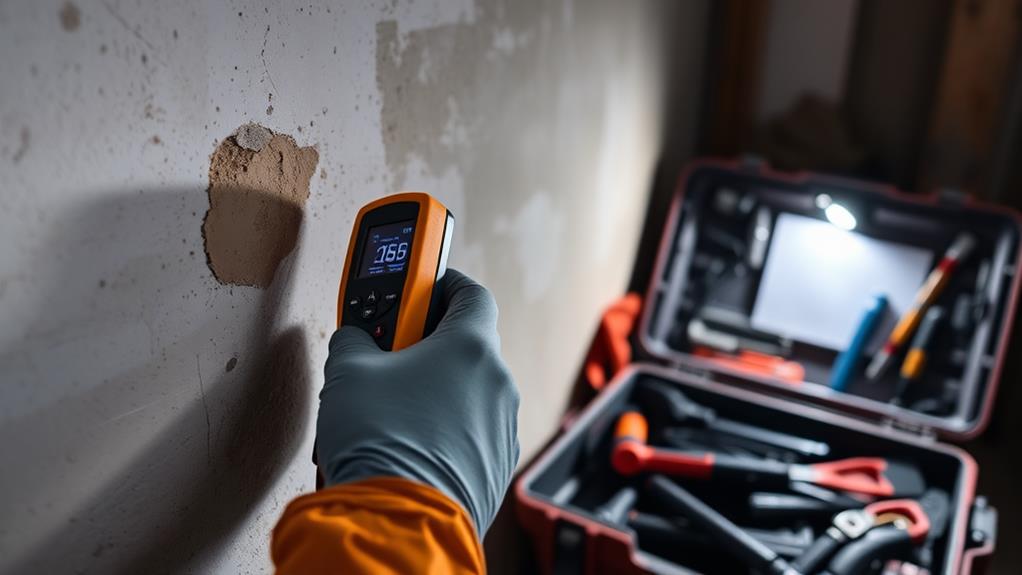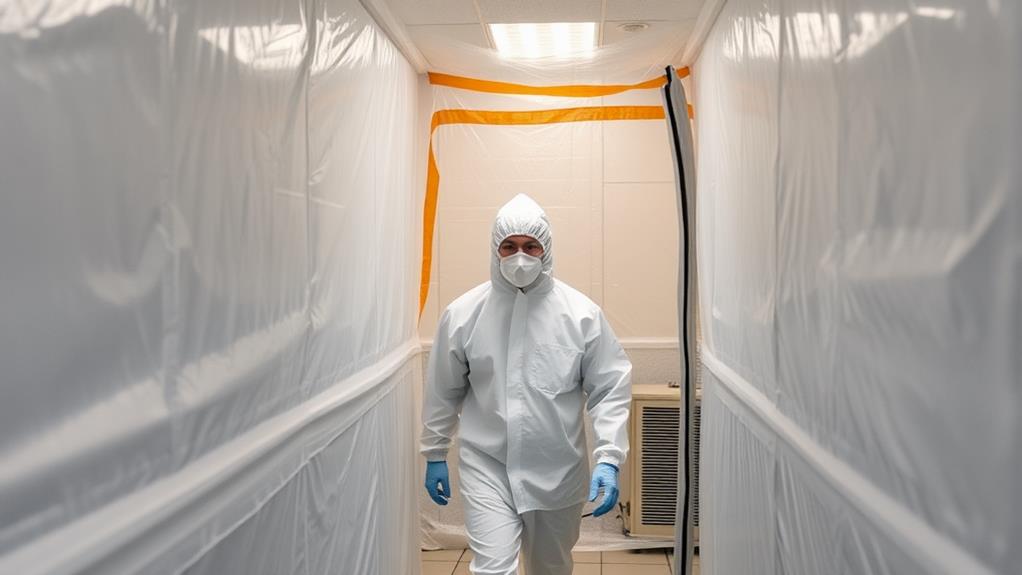Creating a comprehensive mold remediation plan for your entire home involves several key steps. Begin by thoroughly assessing the extent of mold growth through visual inspection and moisture detection. Identify and address all moisture sources to prevent future growth. Develop containment strategies to prevent spore spread during remediation. Choose appropriate removal techniques based on the affected materials and severity of infestation. Implement preventive measures such as improving ventilation and controlling humidity. Finally, establish a monitoring and maintenance routine to ensure long-term success. This systematic approach will help you effectively tackle mold issues and maintain a healthier living environment. The following sections provide in-depth guidance for each step of the process.
Assess the Extent of Mold

Before initiating any mold remediation efforts, it's crucial to assess the full extent of mold growth in your home. This step involves a thorough inspection of all areas, including visible surfaces and hidden spaces like wall cavities, attics, and crawl spaces. Look for signs of water damage, discoloration, or musty odors, which often indicate mold presence.
Use a flashlight to examine dark corners and crevices. Pay special attention to areas prone to moisture, such as bathrooms, kitchens, basements, and around windows. Don't overlook less obvious locations like behind furniture, under carpets, or inside HVAC systems.
For a more comprehensive assessment, consider using moisture meters to detect hidden dampness in walls and floors. In cases of extensive or hidden mold growth, it may be wise to enlist the help of a professional mold inspector. They can perform specialized tests, including air quality sampling, to identify mold types and concentrations.
Document your findings with photographs and detailed notes. This information will be invaluable in developing an effective remediation plan and may be necessary for insurance claims or professional consultations.
Identify Moisture Sources
Mold's persistence in your home hinges on the presence of moisture. To effectively combat mold growth, it's crucial to identify and address all potential moisture sources.
Common culprits include leaky pipes, roof damage, poor ventilation, and high humidity levels. Inspect your plumbing system thoroughly, paying close attention to areas under sinks, around toilets, and behind appliances. Check your roof for missing shingles or damaged flashing that could allow water infiltration.
Assess your home's ventilation, particularly in bathrooms, kitchens, and laundry rooms. Inadequate airflow can trap moisture, creating ideal conditions for mold growth. Use a hygrometer to measure indoor humidity levels, aiming to maintain them below 60%. Investigate any signs of water damage, such as discolored walls, peeling paint, or warped flooring.
Don't overlook less obvious moisture sources like condensation on windows, overflowing plant pots, or damp basements. By systematically identifying and addressing these moisture sources, you can create an inhospitable environment for mold and prevent its recurrence. Remember, successful mold remediation relies on eliminating the conditions that allow it to thrive.
Develop Containment Strategies

With moisture sources identified, the next step in mold remediation is to develop effective containment strategies. These strategies are crucial to prevent the spread of mold spores to unaffected areas during the cleaning process. Begin by sealing off the contaminated area using plastic sheeting and tape, creating negative air pressure to ensure spores don't escape. Install HEPA air filtration devices to capture airborne spores and improve air quality.
For small affected areas, containment may involve covering doorways and vents. Larger infestations require more extensive measures, such as constructing temporary walls or enclosures. Personal protective equipment (PPE) is essential for anyone entering the containment zone, including respirators, gloves, and disposable coveralls.
Establish decontamination areas for workers to safely remove PPE and clean equipment before exiting. Implement a double-bag system for disposing of contaminated materials, ensuring they're properly sealed and labeled. Regular monitoring of containment integrity is vital throughout the remediation process. By developing and adhering to robust containment strategies, you can effectively isolate the affected area, minimize cross-contamination risks, and create a safer environment for both workers and occupants during mold remediation.
Choose Appropriate Removal Techniques
Selecting the right mold removal techniques is crucial for effective remediation. The approach depends on the type of surface affected and the extent of mold growth. For non-porous surfaces like glass, metal, or plastic, a thorough cleaning with detergent and water, followed by disinfection, is often sufficient.
Porous materials such as drywall, carpets, or wood may require more aggressive methods. For small areas (less than 10 square feet), scrubbing with a bristle brush and a mixture of water and detergent can be effective. Larger areas or more severe infestations may necessitate professional intervention.
Techniques like sanding, wire brushing, or media blasting can be employed for stubborn mold on hard surfaces. In some cases, removal and replacement of affected materials may be the best option. HEPA vacuuming is essential for capturing loose mold spores during and after the removal process.
Chemical treatments, such as biocides or encapsulants, may be used in specific situations but should be applied cautiously and only by trained professionals. Always prioritize safety by wearing appropriate personal protective equipment and following proper disposal procedures for contaminated materials.
Implement Preventive Measures

After addressing active mold issues, the focus shifts to preventing future occurrences. Implementing preventive measures is crucial for maintaining a mold-free environment in your home.
Start by controlling moisture levels, as mold thrives in damp conditions. Install dehumidifiers in high-humidity areas and ensure proper ventilation throughout the house, especially in bathrooms, kitchens, and laundry rooms.
Regularly inspect and maintain your home's exterior, including the roof, gutters, and foundation, to prevent water infiltration. Address any leaks promptly, whether from plumbing fixtures or the building envelope. Use mold-resistant products when renovating or repairing, such as mold-resistant drywall and paint. Keep indoor humidity levels below 60% by using air conditioners and dehumidifiers.
Improve air circulation by opening windows when weather permits and using fans. Clean and dry water-damaged areas within 24-48 hours to prevent mold growth. Regularly clean and maintain HVAC systems, including changing filters as recommended. Consider using air purifiers with HEPA filters to remove mold spores from the air. By implementing these preventive measures, you can significantly reduce the likelihood of future mold infestations in your home.
Monitor and Maintain Results
Ongoing vigilance is essential to ensure the long-term success of your mold remediation efforts. Regularly inspect previously affected areas for signs of recurring mold growth, such as discoloration or musty odors. Conduct thorough visual checks of your home's interior and exterior, paying close attention to areas prone to moisture accumulation.
Maintain optimal indoor humidity levels between 30-50% using dehumidifiers or air conditioning systems. Install humidity monitors in key locations to track moisture levels accurately. Promptly address any water leaks or moisture issues to prevent new mold growth. Keep air circulation consistent by using fans and opening windows when weather permits.
Periodically clean and disinfect surfaces with mold-inhibiting products, especially in bathrooms, kitchens, and basements. Replace air filters regularly and consider using HEPA filters to trap mold spores. Document your monitoring efforts and any observed changes to track progress over time.
If you notice any signs of mold resurgence, take immediate action to address the issue. Consider scheduling professional mold inspections annually or bi-annually to ensure comprehensive detection and prevention. By maintaining diligence in monitoring and upkeep, you can safeguard your home against future mold infestations.
Frequently Asked Questions
How Long Does Professional Mold Remediation Typically Take?
Professional mold remediation typically takes 1-5 days, depending on the extent of mold growth and affected areas. Factors influencing duration include the size of the space, type of mold, and necessary restoration work post-remediation.
Can I Stay in My Home During the Mold Remediation Process?
Whether you can stay in your home during mold remediation depends on the extent of the problem. For minor cases, occupancy may be possible. However, for large-scale remediation, temporary relocation is often recommended to ensure safety and efficiency.
Are There Any Health Risks Associated With DIY Mold Removal?
Studies show 50% of homes have mold issues. DIY mold removal can pose significant health risks, including respiratory problems and allergic reactions. Without proper protection and expertise, you may inadvertently spread spores, exacerbating the problem and endangering your health.
How Much Does Professional Mold Remediation Usually Cost?
Professional mold remediation costs typically range from $500 to $6,000, depending on the extent of infestation and affected area size. Factors influencing price include the type of mold, location, and necessary containment measures. Severe cases may exceed $10,000.
Can Mold Return After Remediation if the Underlying Issues Aren't Addressed?
Yes, mold can return after remediation if underlying issues aren't addressed. Moisture sources, poor ventilation, or hidden contamination may lead to recurrence. Effective remediation should include identifying and resolving root causes to prevent future mold growth.
Conclusion
As the final spores are eradicated, a home emerges anew, like a butterfly from its chrysalis. The mold remediation journey transforms living spaces from dank caverns to pristine sanctuaries. Vigilance becomes the guardian of this hard-won purity, with each inspection a reaffirmation of health and safety. The battle against mold is not merely about cleanliness, but about reclaiming territory—both physical and psychological—from an insidious invader, ensuring a fortress of wellbeing for years to come.

